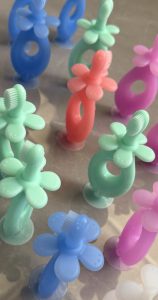The teething phase is a critical developmental milestone in infancy, typically beginning around 6 months of age. During this period, infants experience discomfort due to the eruption of primary teeth through the gums, often accompanied by irritability, drooling, and a strong urge to chew. Baby teethers, specifically designed to alleviate these symptoms, have become indispensable tools for parents. Beyond soothing discomfort, teethers play a vital role in promoting oral hygiene and supporting healthy dental development. This paper explores the significance of teethers in managing teething challenges, fostering oral health, and establishing lifelong dental hygiene habits.
The Teething Process: Challenges and Needs
Teething is a natural but often distressing process for infants and caregivers. As teeth emerge, pressure on the gums triggers inflammation, leading to pain, redness, and swelling. Infants may exhibit behaviors such as biting, drooling, or refusing food. While these symptoms are temporary, they can disrupt sleep and feeding routines, causing stress for families.
Historically, parents relied on remedies like chilled washcloths or rubber toys to ease discomfort. However, modern teethers are scientifically designed to address these needs safely. Their textured surfaces massage gums, counteracting the pressure of erupting teeth, while their chewable materials provide sensory stimulation. Pediatricians emphasize that teethers are not merely comfort objects but essential tools for mitigating teething-related stress.
The Role of Teethers in Oral Hygiene
Infant oral hygiene begins long before the first tooth appears. Gums require care to prevent bacterial buildup, which can lead to infections or early childhood caries. Teethers contribute to oral health in three key ways:
Stimulating Saliva Production
Chewing on teethers promotes saliva flow, a natural defense mechanism. Saliva neutralizes acids, washes away food particles, and contains enzymes that inhibit bacterial growth. This reduces the risk of “bottle caries,” a common issue in infants who consume sugary liquids.
Massaging Gums and Encouraging Blood Flow
Textured teethers gently exfoliate gum tissue, removing debris and improving circulation. Enhanced blood flow supports the healthy development of underlying teeth and strengthens gum resilience.
Introducing Oral Care Habits
Regular use of teethers familiarizes infants with objects in their mouths, easing the transition to toothbrushes later. Studies show that early exposure to oral stimulation correlates with better cooperation during dental hygiene routines in toddlerhood.
Safety and Design: Choosing the Right Teether
Not all teethers are created equal. Safety and material quality are paramount, as infants may chew aggressively or use teethers for prolonged periods. Key considerations include:
- Material Safety
High-quality teethers are made from non-toxic, BPA-free silicone or rubber. Avoid products with small parts or liquid-filled centers, which may pose choking or leakage risks.
- Texture and Functionality
Bumpy or ridged surfaces provide optimal gum massage, while chilled teethers (placed in refrigerators, not freezers) offer numbing relief. Some teethers double as toothbrushes, featuring soft bristles for gentle cleaning.
- Age-Appropriate Design
Teether size and shape should match an infant’s motor skills. For younger babies, easy-to-grasp rings are ideal, while older infants may benefit from teethers with handles or multiple textures.
The American Academy of Pediatrics (AAP) recommends avoiding amber teething necklaces due to strangulation hazards, underscoring the importance of evidence-based choices.
Complementary Strategies for Oral Health
While teethers are invaluable, they should complement—not replace—broader oral care practices:
- Gum Wiping
Before teeth emerge, caregivers should clean gums daily with a soft, damp cloth to remove bacteria.
- First Dental Visit
The AAP advises scheduling a dental consultation by age 1 to assess tooth development and receive personalized advice.
- Dietary Considerations
Limiting sugary foods and ensuring adequate calcium intake support strong tooth enamel.
Conclusion
Baby teethers serve as multifaceted tools in infant care, addressing both immediate teething discomfort and long-term oral health. By selecting safe, well-designed products and integrating them into holistic hygiene practices, parents can safeguard their child’s dental development. As research continues to evolve, teethers remain a cornerstone of pediatric dentistry, embodying the intersection of comfort, science, and preventive care. Ultimately, fostering healthy oral habits in infancy lays the foundation
 seinee
seinee





HelloPlease log in